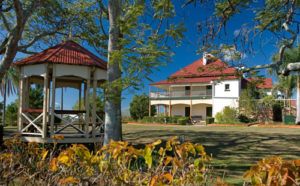Booval House is one of many historic homes in the Ipswich area that has been bought, sold and restored many times throughout its long existence. The land on which Booval House currently resides was originally owned by Mr C. V. Daveney who owned large portions of the Ipswich area. However, it was not until the late 1850’s that Booval house began its formation, when a Mr George Faircloth then Manager of the Bank of Australasia in Ipswich, employed architect William Wakeling and builder William Hancock to carry out the construction of Booval House. Booval House was originally built with 14 rooms which included a bathroom, pantry, wine cellar, laundry and kitchen on a 2 acre block.
Upon its completion Booval House was the first major significant house to be built in the Booval area. Which is why on the 20th of December 1859, Governor Sir George Ferguson Bowen and Lady Bowen stopped there for a bite to eat and a change of clothes before beginning their first visit to the area of Ipswich. As well as being a residence, in the early 1860s the 40 acres surrounding the house were transformed into a cotton plantation. In 1868 Booval House was purchased for approximately 500 pounds by Mr John Ferrett, who later became a member of the first Queensland Parliament. During this time Booval House was a known resting place for the Cobb and Co coaches that were travelling the long distance to Brisbane.
The house eventually passed down to Harry Ferrett, John’s nephew who lived there with his family during the 1893 floods. During this flood, Booval House became a safe place for many of the residents in the local area as most had lost their houses in the devastation. In 1896 a new iron roof and a timber extension was added to the rear of the house both designed by Ipswich architect George Brockwell Gill. It wasn’t until 1921 that the house and several acres of land was sold out of the Ferrett family to the Catholic Church for 900 pounds who promptly renovated and reopened the building in 1930 for use by St Gabriel’s Convent for the Sisters of Mercy. In 1946 a number of house features were rebuilt because of whiteant damage, including the verandah which was converted to brick. A further extension was added in 1969 which included the addition of further rooms and a chapel.
Due to the decline in the number of Sisters entering the Catholic Church, Booval House stood vacant from 1980 until 1997 when it was sold to Dr John and Helen Jackson who bought the house with the intention of restoring it to its former glory. This took a number of years and in 2002 Booval House was recognised by the National Trust and received a gold medal for conservation work in the John Herbert Heritage Awards. Today the magnificently restored Booval House is once again up for sale as too are the great moments it has seen throughout the history of Ipswich and Queensland.
Information taken from – The Queensland Times: “Booval House – Where the Governor came for lunch”, The Queensland Government Environmental Protection Agency and The Ipswich Heritage Study.

